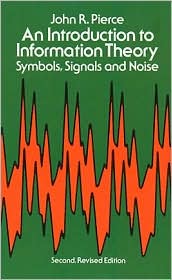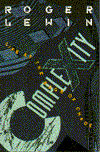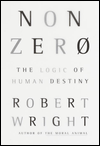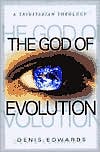Of late I have been scrutinizing William A. Dembski's argument in
Intelligent Design that nature's "complex specified information" (CSI) vouches for God's design in the results of biological evolution.
The Fruits of Flow (I.D. XXIII) was my most recent post along these lines. In it, using an argument based on earlier posts in the series, I decided that CSI alone is insufficient to Dembski's purpose.
I said that an informational "event" that possesses sufficient complexity (read, improbability) and whose pattern (as its "specification") can be derived from "background information" independent of the event itself does not necessarily imply design. For example, an
adaptational event that is ratified by natural selection possesses the requisite complexity, and its target pattern, Darwinian fitness itself, serves admirably as an independent specification. So such an event
is CSI ... and it is not produced by direction or design.
I also said that the type of self-organization Stuart Kauffman proposes in
At Home in the Universe when he talks of life's origin in collectively autocatalytic sets combines the requisite complexity with the requisite specification. In this case, the independently specifiable target pattern is catalytic closure, in which the production of new copies of every protein in the set is facilitated by the presence of one or more of the set's other proteins. Catalytic closure (plus a handful of other necessities, such as a rudimentary cell wall) turns a prebiotic soup into a protocell that can self-reproduce ... and it is a pattern that is independently specifiable based on background information.
Here again, I said, is an example of Dembskiyan CSI that is not designed.
And it is more, I now wish to add. I think self-organized complexity is the fundamental Achilles' heel of Dembski's argument to design.
Crucial to Dembski's argument is his idea that nothing in the natural world can create
nature's own CSI — not natural law, not chance, not any combination of the two. He uses reasoning based on the determinsim of mathematical functions to show that law (i.e., necessity) only moves CSI around; it doesn't create it. Likewise, chance cannot be reasonably ascribed as a source of CSI when it, the CSI, is vastly improbable. Furthermore, in a clever proof, Dembski shows that
combinations of necessity and chance are impotent to originate CSI.
What he misses is that lawful behavior à la Kauffmanian self-organization can turn complex
unspecified information into CSI. It can fabricate a previously absent specification as an
emergent property of a self-organizing system.
For example, when a set of proteins in a prebiotic soup becomes sufficiently complex, it gains catalytic closure as an emergent property that then undergirds self-reproduction, heritable variation (generational changes in the roster of proteins in the set), and Darwinian evolvability.
Another way to look at it is that self-organizing systems "export entropy." Entropy is disorder, the opposite of information.
Entropy is a construct in both information theory and, in the physical sciences, thermodynamics and statistical mechanics. When Kauffman says self-organization produces "order for free," he is saying, I think, the same thing as that such systems export entropy. For they are canonically open, nonequilibrium systems that take in food and energy and expel waste. I imagine that this dissipative process can be understood both thermodynamically
and in terms of the flow of information.
As I hope I succeeded in showing in
Information, Order, and Entropy (I.D. XXI), the exportation of entropy "creates" information only in a local sense. That is, when you mentally place the system in question inside a tight spatial frame and also within a narrow temporal bracket, it looks like new information magically appears: order for free.
For example, I said, if a system is framed as just a gas-filled cylinder-with-piston, omitting the external weight to which the piston attaches and which conserves the entropy exported by the piston, and if you bracket the system temporally such that it is "born" at the beginning of the piston's inward counterstroke and "dies" at the end of that counterstroke, it looks as if the entropy of the system
decreases over the system's "lifetime." During this span of time, order and information emerge magically within this notably
open system.
Globally, however, no new order or information is created; Dembski is right on this point. Removing the spatial frame and temporal bracket that we have placed around the physical "system" and its "lifetime," we can easily see this.
But never mind. Locally, there is within a self-organized living system an anti-entropic "order for free," and,
to that system, this is what counts.
Kauffman hopes someday he can be empirically proven right when he says that collectively autocatalytic sets of proteins are very, very likely to appear in a primordial soup. If so, they would furnish nature with her first lifelike entities, which could then go on to leverage heritable variation and evolve, Darwin-style, under the aegis of blind natural selection.
If this is what happened on the early earth, then somehow, at some point in time, the evolution of these first protocells introduced
within the cells a genome made of DNA, and
true Darwinian evolution began. But, at first, there was (Kauffman says) no separate genome. In biologists' lingo, there was at first no distinction between the "genotype" and the "phenotype."
Possibly the inclusion of a separate genome happened in the way some biologists hypothesize for the origin of cell nuclei: the originally nucleus-free cells "ate" other cells and forevermore turned those cells into their nuclei.
But, no matter. What is crucial here is that the very
first step to a biosphere that could then go on to evolve through mutation-cum-natural-selection was (if Kauffman is right) a self-organized one. By sheer chance — but with notably
high probability — enough proteins got together to form a collectively autocatalytic set, and bang!
So life is, first and foremost, an entropy exporter. It staves off disorder and death by creating, locally to itself, order for free. Bounded by its own birth and death, and within its own cell walls, it does what Dembski says it cannot: create information.
Never mind that it actually "steals" this information from abroad, and someday will have to put it back. Ashes to ashes, dust to dust ... but meanwhile, life flourishes in the here and now.
This is why I say that, so viewed, life itself provides Dembski's argument to intelligent design with its Achilles' heel. True, no information within nature
as a whole can be created
by nature. But place
part of nature within an appropriate spatial frame and apt temporal brackets, and if self-organization chances to transpire within that locality, life
and evolvability emerge. Creatures learn to export their own entropy, defy all logic, and thrive.
This is not to say that there is no God. Nor is it to say that unaided nature can, evolving as Darwin proposed, produce the
irreducible complexity which Dembski and his cohort Michael Behe insist organs like an eye or a wing represent.
I don't claim to know for certain whether the eye, to take one oft-cited example, is irreducible complex. If it is, then that would very likely mean natural selection, which can account for only
cumulative complexity, would be walled off from it.
But Darwin's defenders, Richard Dawkins prime among them, claim the eye is only cumulatively complex.
I can't resolve that dispute. Furthermore, I feel little motivation to try. For I happen to believe in God, even if Dawkins is right.
Even if the eye, or the wing of a bird, or sonar in bats actually developed by the ultra-slow, step-by-step accretion of very minor changes, this fact to me does not exclude God from evolution. What it does do, I think, is exclude the
provability of God in evolution. And that is quite a different matter.
Before embellishing that point, at this juncture I would like to mention one other thing. As of this present moment, it is a pure hunch of mine. If I read Kauffman aright, self-organization does more that just kick-start life and its consequent evolution. Once life begins, self-organization also potentiates evolvability itself.
By that I refer to such things in Kauffman's discourse as the "evolution of co-evolution." Kauffman presents a long, involved discussion of this topic; I won't rehash it here. The gist of it is that species in ecosystems co-evolve — they do a dance in which changes in one species keep step with changes in others. For example, when finches live by harvesting nectar from blossoms whose tubes lengthen over evolutionary time, so, too, do the bills of the finches.
Or, when frogs' tongues are adapted to zotting delicious flies whose DNA, in turn, adaptively "learns" to secrete oil from the flies' feet, the frogs' DNA will "learn" to roughen the surface of froggy tongues, to neutralize the slipperiness of the oil.
Such is co-evolution — a process which itself is fraught (Kauffman says) with self-organization. The same principles which guide
any self-organizing system to the orderly, but not
too orderly "edge of chaos" — the "place" where homeostasis and graceful evolvability emerge — apply to co-evolving ecosystems. Taken as a system-of-systems, an ecosystem at the edge of chaos possesses much more evolvability than would otherwise be expected. In a word, it is much more
fecund a source of evolutinary change.
My hunch, then, is this: a self-organized, co-evolving ecosystem, poised at the edge of chaos, can over time and in conjunction with purely Darwinian principles produce results that seem, in retrospect, like "irreducible complexity."
For the nonce, accordingly, my answer to Michael Behe and others who point to irreducible complexity as a sign of God's intelligent design is this: first, you'd better show definitively that Stuart Kauffman's "laws of self-organization and complexity" can't account for it.
So, with this post, I intend to stop addressing Dembski's and Behe's arguments to intelligent design directly, at least for a while. I'd like to change gears and start talking about a larger view of questions raised by evolution. In this view, the key concept is not intelligent design, it is "divine action."
"Divine action" is an umbrella term used by theologians who inquire into such questions as, "Does God intervene in quantum events to turn their inherent uncertainty into the seeds of providential worldly change?" I myself am unconvinced that this is so, but some experts on science and theology say it may be.
 |
Arthur
Peacocke's
Paths from
Science
Towards
God |
As for myself, I tend to go along with those, like Arthur Peacocke, who say (see his
Paths from Science Towards God) that divine action is a matter of "top-down causation" or "whole-part influence." More on that in later posts, but the basic idea is that the types of complex systems which Stuart Kauffman and others deal with have bottom-up emergent properties
and they also have top-down holistic effects.
In the latter, influences on the system-as-a-whole "trickle down" to become influences on the component parts of the system. Those parts in turn may be complex wholes with their
own internal trickle-down effects. Down through any number of tiers of emergent complexity, causative influence which began
outside the system-of-systems can spread.
Imagine God as treating the world-as-a-whole as a complex system-of-systems. Into it, God occasionally feeds information. Peacocke says it is
pure information, with no concomitant energy input that would invalidate the second law of thermodynamics. This new information trickles down from level to level of the world-system-as-a-whole and, by dint of whole-part influence, causes entities within the world to experience events which otherwise wouldn't be in the cards for them.
And so on. Because the world is made of complex systems that have self-organized à la the insights of Stuart Kauffman (whose research Peacocke mentions only in passing) we can conclude that this very bottom-up/top-down structure furnishes a way for God to influence what goes in within it.
Such divine causal influences, if they exist, are subtle and mainfestly beyond the ability of science to pin down. We would not expect them to qualify as creating complex specified information of the type Dembski expects.
But they might well give evolution a drift which Darwin, as a scientist, could never have explained.





















